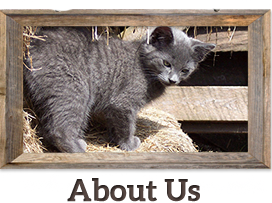Library
-
A cat’s claws are an integral part of their anatomy. Scratching behaviors are normal and serve many purposes, yet cats can cause damage and injury with their claws. By gaining an understanding of the reason that your cat uses her claws, you can provide her with alternative outlets and prevent her from causing damage to your property.
-
Socialization is the process during which the kitten becomes familiar with people, other animals, and many aspects of their environment. Kittens are primed for socialization when they are between two and seven weeks old. As soon as kittens have settled into their new home, they can begin gentle exposures to a wide range of stimuli that they may encounter as adults.
-
Many pets are sensitive to being restrained for grooming. With slow progress and positive rewards, your pet can learn to accept or even enjoy having their teeth cleaned.
-
When leaving home for vacations, pet owners are confronted with the problem of what to do with their pets. Should they take them along or leave them at home? Reviewing a summary of boarding options and travel guidelines will make the decision easier while safeguarding the well-being of your pet and providing your own peace of mind.
-
Deafness does not affect a cat's learning abilities, but it does impact what kinds of cues they can learn. The keys to success are choosing a set of consistent signs and signals and learning what the cat finds rewarding. Deaf cats need special supervision such as leashing or a catio if allowed outdoors, and may startle more easily than cats that can hear, but otherwise can be trained with all the same methods used for a cat with normal hearing.
-
Caterwauling is cat vocalization that sounds like a combination of a yowl, a howl, and a whine. This disturbing noise may result from medical problems, physical needs, hormonal stimulations, or emotional insecurities. The response to caterwauling should focus on addressing the cat's circumstances and filling their needs.
-
It can take a week to a year to introduce or reintroduce cats—you cannot rush the process. The cats must remain separated unless supervised. If there is steady progress but still specific contexts in which aggression continues, you likely need to consult a behavior professional who can recommend other strategies. Alternatively, the cats may need always to be supervised or separated to prevent conflict at high-risk times.
-
Cats exhibit a wide range of behaviors that are quite normal yet may be considered undesirable by the people with whom they share their homes. Most of these behaviors develop to satisfy an innate need. Rather than trying to stop your cat from engaging in instinctual and naturally rewarding behaviors, it is essential to provide your cat with substitute behaviors and outlets that satisfy your cat’s needs.
-
Treats are a wonderful way to provide positive reinforcement to your cat during a training session. Choose low-calorie foods such as green beans, zucchini squash, and watermelon. Avoid foods that are potentially harmful, such as chocolate, garlic, onions, raisins, grapes, macadamia nuts, and products that have xylitol. Limit high-calorie treats and keep treats within 10% of your cat's daily calorie intake. Keeping training sessions short and engaging while providing appropriate foods as treats can be a wonderful way to strengthen the human-animal bond.
-
Pets readily learn to engage in appropriate, desired behaviors through positive reinforcement methods. Reward-based training improves communication and provides enrichment for pets and people alike.


